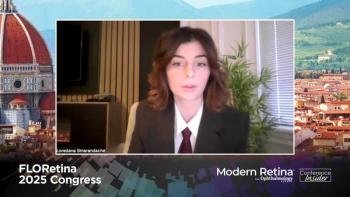
Angiogenesis 2023: What the Talon Phase 3b study results mean for neovascular AMD
Carl D. Regillo, MD, highlights the Talon Phase 3b results for brolucizumab vs aflibercept in a matched treat-and-extend superiority study for neovascular AMD at the virtual 2023 Angiogenesis conference.
Carl D. Regillo, MD, highlights the Talon Phase 3b results for brolucizumab vs aflibercept in a matched treat-and-extend superiority study for neovascular AMD at the virtual 2023 Angiogenesis conference.
Editor's note: This transcript has been edited lightly for clarity.
Sheryl Stevenson: We're joined today by Dr. Carl Regillo of Wills Eye Hospital. We're delighted to have you at this year's virtual Angiogenesis meeting. Could you take a couple minutes and tell us about the results of the Talon Phase 3b study?
Carl D. Regillo, MD: Sure. Thanks, Sheryl. Glad to be here. The Talon Phase 3b study is a unique study. In fact, it's the first of its kind to have identical, variable, individualized treatment regimens. We call it treat and extend.
This study was designed to mimic, to be most accurate as possible, to create what we do in clinical practice: treat and extend but to maintain the macula in the driest possible state. That's what we do in practice. What we did here was randomize patients in 1: 1 fashion in this double-masked, prospective, large-scale international clinical study, where patients were getting either the brolucizumab standard 6 milligram FDA-approved dose, or the standard 2-milligram aflibercept dose, with some loading doses monthly and then every other month, and then by 4 week extensions treat and extend all the way out to 16 weeks. There were two endpoints: the primary endpoint at 32 weeks, and the final endpoint or final study assessment at 64 weeks. That's the new data that I presented.
Stevenson: Were the results what you expected them to be? Were there any surprises or any other discoveries that came out along the way?
Regillo: Well, actually, the study really has very interesting results. It says, with certainty, proven that brolucizumab does indeed last longer, has greater durability than aflibercept. Now, we knew that at the primary outcome when I first presented this at the ASRS meeting in 2022. This held true all the way to the final outcome where patients were allowed to be extended up to 16 weeks.
What we're seeing here is a much smaller proportion of patients being treated with brolucizumab compared with aflibercept, frequently, every 4, 8 weeks or so and a much larger percentage of patients being extended out 12 and 16 weeks. In fact, over double the amount of patients were successfully managed; that is, maintained in a dry macular fashion at 16 weeks compared with aflibercept.
Previous studies gave us the suggestion that brolucizumab might last longer but this is actually the proof. They're identical treatment regimens and held all the way into year 2, the final outcome at 64 weeks. Keep in mind though not only is it more durable; of course, durability means nothing if it doesn't maintain the vision gains. In fact, brolucizumab was visually noninferior to aflibercept with essentially identical like vision gains, all the way through the entire course of the study up to 64 weeks.
Stevenson: What does this study mean long range for clinicians and their patients?
Regillo: Well, you know, we knew brolucizumab was an effective medicine. We had that sense it lasted longer. Now we have that proof. I think the study design is a good one for future studies and future comparisons of other therapeutics. Brolucizumab has been on the market and FDA approved now for several years with the treatment of neovascular AMD. It's been held back because of a safety profile with higher rates of intraocular inflammation and certain adverse event rates that are higher than the drugs we had been using. That was also seen in the Phase 3b Talon study. That's not a surprise. The safety profile was similar to what we saw in the brolucizumab Phase 3 pivotal studies. And that holds back its particular usage in the setting of neovascular AMD so when you think: Oh, if it works as well, but lasts longer, we'd be using that first line. Unfortunately, because the safety is not quite as good, it's not really going to be used first line.
Nonetheless, it gives us confidence that we might be able to use it accepting those higher risks if we want to get greater durability for our patients. And then, of course, newer drugs being introduced, such as faricimab and maybe even later this year high-dose aflibercept may also show similar durability.
Newsletter
Get the essential updates shaping the future of pharma manufacturing and compliance—subscribe today to Pharmaceutical Technology and never miss a breakthrough.




